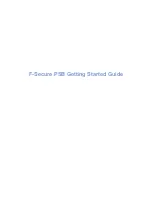
Default Settings
33
If the subsystem being configured is a clone of another subsystem, then the backup files for the
master subsystem must be locally accessible.
2.3.2. Default Settings
The ports and file directories in
Table 2.1, “Default Subsystem Instance Ports and File Locations”
show
the default installation and configuration information.
Susbsystem
SSL Port
Non-SSL Port
Instance Directory
CA
9443
9080
/var/lib/rhpki-ca
DRM
10443
10080
/var/lib/rhpki-kra
OCSP
11443
11080
/var/lib/rhpki-ocsp
TKS
13443
13080
/var/lib/rhpki-tks
TPS
7889
7888
/var/lib/rhpki-tps
Table 2.1. Default Subsystem Instance Ports and File Locations
The following certificates are created by default when any of the following subsystem instances are
installed:
• Certificate Manager
• CA signing certificate
• OCSP signing certificate (for the CA's internal OCSP service)
• SSL server certificate
• Subsystem certificate
The subsystem certificate is always issued by the security domain so that domain-level operations
that require client authentication are based on this subsystem certificate.
• DRM
• Transport certificate
• Storage certificate
• SSL server certificate
• Subsystem certificate
• OCSP
• OCSP signing certificate
• SSL server certificate
• Subsystem certificate
• TKS
• SSL server certificate
Summary of Contents for CERTIFICATE SYSTEM 7.3 - ADMINISTRATION
Page 15: ...xv Index 525 ...
Page 16: ...xvi ...
Page 38: ...Chapter 1 Overview 16 Figure 1 4 Certificate System Architecture ...
Page 82: ...Chapter 2 Installation and Configuration 60 rpm ev rhpki manage ...
Page 154: ...132 ...
Page 194: ...172 ...
Page 238: ...216 ...
Page 244: ...222 ...
Page 246: ...224 ...
Page 286: ...264 ...
Page 292: ...270 ...
Page 318: ...Chapter 13 Certificate Profiles 296 Parameter IssuerType_n IssuerName_n ...
Page 321: ...Freshest CRL Extension Default 299 Parameter PointName_n PointIssuerName_n ...
Page 398: ...376 ...
Page 412: ...390 ...
Page 472: ...450 ...
Page 506: ...484 ...
Page 528: ...506 ...
Page 546: ...524 ...
















































